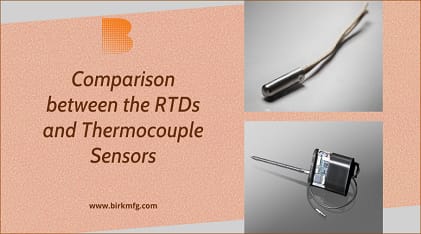A temperature sensor is a device that senses the temperature of a surface or the surrounding environment. There are different types of temperature sensors, and of these, thermocouples and RTDs are the most popular. Although these sensors are designed for the same purpose, they differ in several aspects such as construction, working principles, and temperature range. Therefore, it is essential to consider their differences when it comes to choosing the temperature sensors for your industrial applications. This post offers a comparison between the construction, working principles, and operating capabilities of RTDs and thermocouple sensors.
Comparison between RTDs and Thermocouple Sensors
- Construction: There are a number of differences in how these sensors are constructed.
- RTDs: The construction of an RTD features a non-ferrous core material and a metal wire/lead. The wire is wound on the ceramic or glass core to create the RTD. The metal wire can be made from platinum, nickel, copper, etc.
There are different types of RTDs that can be manufactured from this construction. Surface mount RTDs and probe RTDs are the most common types used in industries. - Thermocouples: The construction of these sensors features two dissimilar conductor materials connected to each other at two junctions. Thermocouples may feature conductor pairs such as platinum/rhodium-alloy, tungsten/rhenium-alloy, etc. This creates a wide range of thermocouple types, including J and K-type thermocouples.
- RTDs: The construction of an RTD features a non-ferrous core material and a metal wire/lead. The wire is wound on the ceramic or glass core to create the RTD. The metal wire can be made from platinum, nickel, copper, etc.
- Working Principles: RTDs and thermocouples measure temperature using two different but equally accurate methods, as described below.
- RTDs: This sensor operates on the correlation between metals and temperature. As the temperature rises, so does the resistance of the metal. The RTD detects this change in resistance and can correlate it to a specific temperature.
- Thermocouples: This device operates based on the Seebeck effect. This effect is seen when a closed circuit is created by joining two dissimilar metals at two separate junctions. When a difference in temperature is observed by the junctions, an electromotive force (e.m.f.) is induced in the circuit. This induced voltage can be correlated to the temperature.
- Temperature Measurement Range: RTDs offer temperature measurements up to 400°C, and advanced high temperature RTDs can measure even higher temperatures. Thermocouple sensors can offer temperature measurements up to 2500°C.
- Sensitivity: The measuring sensitivity of thermocouple sensors is nearly three times that of RTDs.
- Accuracy: RTDs offer higher accuracy than thermocouple sensors. The accuracy of RTDs is up to 0.1°C, whereas for thermocouples it fluctuates between 1-2°C.
- Stability: The graphical representation of temperature measurements found using RTDs gives a linear temperature-resistance relation, which shows that readings from RTDs are stable. On the other hand, temperature measurements using thermocouples result in an S-curve as a graphical representation. Thermocouples are exposed to measurement drift due to chemical changes in metals such as oxidation and other related changes in the function of the electrical junction. Therefore, measurements of thermocouples may fluctuate.
After learning about the differences between RTDs and thermocouples, you are better placed to choose the temperature sensor that suits your applications. However, ensure that you source these temperature sensors from trusted manufacturers or suppliers like Birk Manufacturing, Inc. The company offers a wide range of surface mount RTD sensors, thermocouple sensors, and other temperature monitoring and control solutions.
